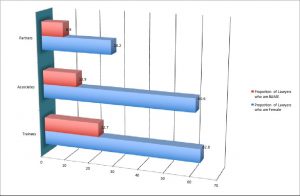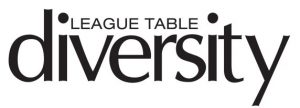We were delighted to launch and release the findings of the 2017 edition of BSN’s Diversity League Table: 10-year Study (DLT2017) at a launch event hosted by Latham & Watkins on 19 June 2017.
By way of background, BSN’s Diversity League Table (DLT) was first published in 2006 and is an annual survey of participating leading firms and chambers in the UK across four diversity strands of gender, ethnicity, sexual orientation and social mobility. At its inception in 2006, the DLT represented a ground-breaking piece of work that pre-dated all current cross-strand diversity monitoring initiatives and regulatory requirements, leading to greater transparency around diversity measures in the legal profession. Over the years, the DLT has become widely considered as the profession’s leading diversity reporting initiative and an invaluable tool for stakeholders in measuring the impact of diversity practice and policy.
After 10 successful years of the DLT, we at BSN have re-evaluated the publication as a diversity survey and measure in consultation with The Law Society who are DLT’s lead sponsor.
As a first step, we commissioned a review and analysis of the datasets collected from law firms over the past 10 years of the DLT. That has culminated in this latest publication which focuses on aspects of change from a demographic perspective (across diversity stands of gender, ethnicity and social mobility) over this period. This report presents new and useful insights on the progress, drivers and barriers of diversity in the legal profession, exploring those firm-level characteristics that are most closely associated with higher or lower levels of diversity within a firm [*1].
Headline findings:
Since the DLT’s inception, the proportion of individuals from Black, Asian and Minority Ethnic (BAME) backgrounds entering the profession has almost doubled to around 20% and there has been a marked increase in women solicitors.
 Source: Diversity League Table, 2006
Figure 2: Diversity across Levels of Legal Practice, 2015
Source: Diversity League Table, 2006
Figure 2: Diversity across Levels of Legal Practice, 2015
 Source: The Law Society (2016), Trends in the Solicitors' Profession
* Note: (i) the Partner figures in this diagram do not consider Sole Practitioners as ‘Partner’ equivalents and so deviate somewhat from the Law Society’s statistics.
(ii) BAME trainee figure is for 2013, as more recent Law Society publications do not cite the proportion of Trainees who are BAME, following changes to the way that ethnicity data is collected by the SRA.
[1] The analysis involved using firm-level panel data (collected from DLT participating law firms over the period) to estimate multivariate regression equations; separately modelling proportion of (i) female and (ii) BAME staff at (a) Partner, (b) Associate and (c) Trainee level in the firm. This approach helps to get closer to ‘causal’ relationships but even with a multivariate approach, we are dealing with ‘correlation’.
[2] See figures 1. and 2.
[3] 2015 figures (reported in 2016) available from The Law Society.
The above is an extract, BSN are pleased to present the full digital editions of DLT: click here to read.
Source: The Law Society (2016), Trends in the Solicitors' Profession
* Note: (i) the Partner figures in this diagram do not consider Sole Practitioners as ‘Partner’ equivalents and so deviate somewhat from the Law Society’s statistics.
(ii) BAME trainee figure is for 2013, as more recent Law Society publications do not cite the proportion of Trainees who are BAME, following changes to the way that ethnicity data is collected by the SRA.
[1] The analysis involved using firm-level panel data (collected from DLT participating law firms over the period) to estimate multivariate regression equations; separately modelling proportion of (i) female and (ii) BAME staff at (a) Partner, (b) Associate and (c) Trainee level in the firm. This approach helps to get closer to ‘causal’ relationships but even with a multivariate approach, we are dealing with ‘correlation’.
[2] See figures 1. and 2.
[3] 2015 figures (reported in 2016) available from The Law Society.
The above is an extract, BSN are pleased to present the full digital editions of DLT: click here to read.
- As a result, the proportion of BAME and female partners has increased [*2]. However, the levels of attrition as one moves up the professional ladder mean that only 8% of partners are from an ethnic minority background, despite 22% of trainees being from an ethnic minority background. And around a quarter of partners are female, despite the fact that 60% of trainees are female.[*3]
- A higher Policy Score (which reflects the extent to which a firm is adopting ‘good practice’ measures to promote and support diversity) appears to be associated with lower levels of gender diversity at partner and associate level. This is likely due to firms with lower levels of diversity adopting strategies to overcome this (raising their Policy Score) but this does not seem to significantly improve subsequent levels of diversity.
- Firms with a higher proportion of trainees from Oxbridge or Russell Group universities have lower levels of subsequent gender diversity at associate and trainee level. High levels of trainees from these more exclusive universities is also associated with lower levels of ethnic diversity at associate level within the firm.
 Source: Diversity League Table, 2006
Figure 2: Diversity across Levels of Legal Practice, 2015
Source: Diversity League Table, 2006
Figure 2: Diversity across Levels of Legal Practice, 2015
 Source: The Law Society (2016), Trends in the Solicitors' Profession
* Note: (i) the Partner figures in this diagram do not consider Sole Practitioners as ‘Partner’ equivalents and so deviate somewhat from the Law Society’s statistics.
(ii) BAME trainee figure is for 2013, as more recent Law Society publications do not cite the proportion of Trainees who are BAME, following changes to the way that ethnicity data is collected by the SRA.
[1] The analysis involved using firm-level panel data (collected from DLT participating law firms over the period) to estimate multivariate regression equations; separately modelling proportion of (i) female and (ii) BAME staff at (a) Partner, (b) Associate and (c) Trainee level in the firm. This approach helps to get closer to ‘causal’ relationships but even with a multivariate approach, we are dealing with ‘correlation’.
[2] See figures 1. and 2.
[3] 2015 figures (reported in 2016) available from The Law Society.
The above is an extract, BSN are pleased to present the full digital editions of DLT: click here to read.
Source: The Law Society (2016), Trends in the Solicitors' Profession
* Note: (i) the Partner figures in this diagram do not consider Sole Practitioners as ‘Partner’ equivalents and so deviate somewhat from the Law Society’s statistics.
(ii) BAME trainee figure is for 2013, as more recent Law Society publications do not cite the proportion of Trainees who are BAME, following changes to the way that ethnicity data is collected by the SRA.
[1] The analysis involved using firm-level panel data (collected from DLT participating law firms over the period) to estimate multivariate regression equations; separately modelling proportion of (i) female and (ii) BAME staff at (a) Partner, (b) Associate and (c) Trainee level in the firm. This approach helps to get closer to ‘causal’ relationships but even with a multivariate approach, we are dealing with ‘correlation’.
[2] See figures 1. and 2.
[3] 2015 figures (reported in 2016) available from The Law Society.
The above is an extract, BSN are pleased to present the full digital editions of DLT: click here to read.


